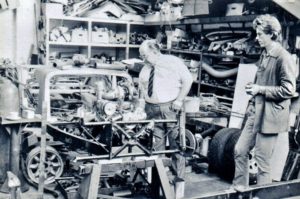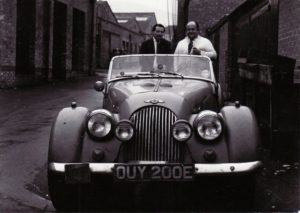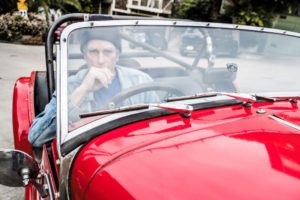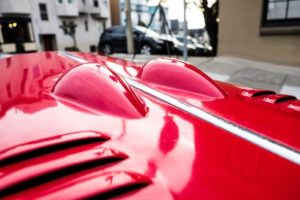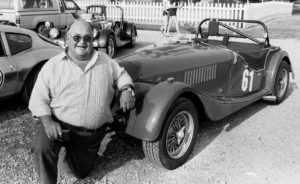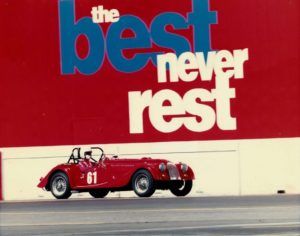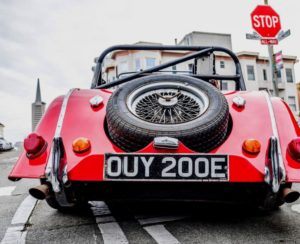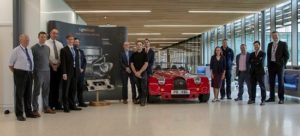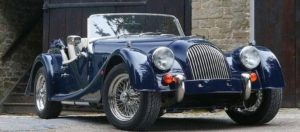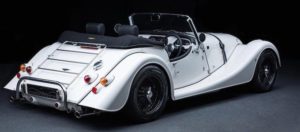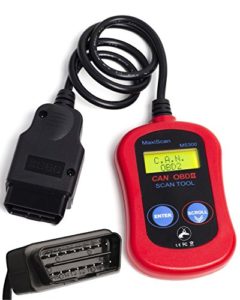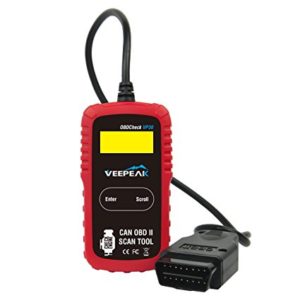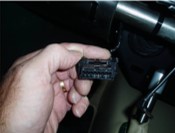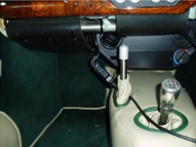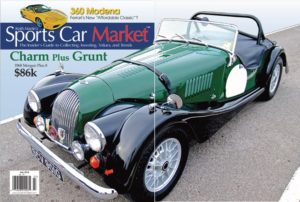
Plus 8 Chassis number: R7022
Searching for new engines in the 1960s, Morgan concluded a deal with Rover for supply of its all-aluminum 3.5-liter V8, thus creating a car — the Plus 8 — that combined vintage charm with Cobra-like grunt.
Morgan’s Plus 4 chassis, strengthened and extended, formed the basis of the new car, while the existing Moss 4-speed gearbox was retained. After a successful debut at the 1968 London Motor Show, production commenced at about 15 cars per month and continues to this day, although they now have BMW power.
While the traditionally styled Morgan’s brick-like aerodynamics restricted top speed to around 125 mph (more than fast enough for most people driving an open car), the Rover V8’s 168 bhp and 210 ft-lb of torque made for supercar performance through the gears. Indeed, in its later 3.9-liter form, the Plus 8 proved quicker by 80 mph than the contemporary Porsche 911 Turbo.
This all-matching-numbers early Morgan Plus 8 is the 22nd example of this landmark V8-engined model to leave the factory.
It was supplied new in February 1969 to the Half Moon Garage in Yorkshire. [The picture shows a RHD car. Reduced Value in the US? Many would say so, but I personally like them. In my mind, it adds credibility to a British Sports car. Mark]
Benefiting from a six-year, six-figure, ground-up restoration undertaken in the USA from renowned marque specialist and concours-winner the late Robert Couch, the car must be one of the best of its kind currently available.
Robert Couch is famous as restorer of the historic Morgan TT Replica CAB 652, previously campaigned by Peter Morgan, which in 1980 was overall winner of the prestigious Chinetti Concours at Lime Rock.
Carried on a new chassis, the aluminum body benefits from an all-new timber framework. Restored for Morgan’s 75th anniversary, although it did not make it to the U.K. for the celebrations, this Plus 8 comes with concours awards testifying to the quality of the restoration.
Acquired from the estate of the late Stephen S. Lester, SCV 901G has been stored in a climate-controlled facility as part of an extensive private collection of vehicles where it has been looked upon as a work of art.
The Morgan recently got an update that was done over two years. The work included a brand-new race engine installed by JE Developments, a recognized specialist in the preparation of Rover V8 engines. This engine breathes via SU carburetors to accommodate FIA regulations.
The other race engine built by Robert Couch had on tap a massive 288 bhp and 275 ft-lb of torque (documented) and is included in the sale.
Despite its greatly enhanced performance, this car is said to cope equally easily with town driving or touring, and must be one of the quickest road-going first generation Plus 8s around.
For a year of its time away, the Morgan was at Richard Thorne’s workshop being fitted with every new FIA update required for historic racing, hillclimbing, and rallying anywhere in the world (Period G1 1966–69, valid to December 31, 2026).
All the work was bespoke in order to avoid drilling the body or dashboard to accommodate cut-off switches. The new FIA roll bars (front and rear) were custom made to ensure a perfect fit, while the side-impact bars were taken down below the door line to make getting in and out as easy as normal.
All this was done at great expense in order to preserve Robert Couch’s original workmanship. Even the spare-wheel cover has no external screws securing it to the rear frame; it simply slides in from underneath, making it easy to remove in order to refit the rear bumper and spare wheel for rally events. The car comes complete with full weather equipment, spare wheel, boot rack and tonneau cover (made to fit the new roll bars).
This well-documented car comes with its original restoration bills and is described as perfect for all uses.
SCM Analysis
This car, Lot 64, sold for £61,980 ($86,390), including buyer’s premium, at Bonhams’ Goodwood Members’ Meeting sale near Chichester, U.K., on March 18, 2018.
This is a slightly strange one. It’s a concours-restored car got up as a racer, but it doesn’t appear to have raced. [A stock car prepared as a competition car but without any competition provenance is, in my opinion, simply a ‘bitsa’. I personally question the value (the seller did really well here!) and would prefer to buy a stock car. Mark]
It was offered — but didn’t sell — at Bonhams’ pre-Christmas sale at Olympia, London, when the original Holley-carbed engine was displayed on a stand behind it, but it had better luck here.
Lots of events — but not all of them
The car’s condition is beyond reproach, with several neat (though unnecessary for a racer) touches. It could easily be raced. Competition car sales history tells us that it’s always cheaper to buy someone else’s hard graft rather than build your own, but you’d have to accept that it would rapidly acquire some patina as some of the shine got knocked off. [People are attracted to ‘shiney’ things . . . Mark]
But here’s the thing: It’s got FIA papers, but it’s Period G1 (1966– 1969) while most prestige events run to Period F (pre-1966) or have an even earlier cut-off of pre-1963.
As our subject car was built in 1968, circuit racing opportunities will not include such events as the Goodwood Revival. Perhaps its most obvious home is in the Historic Sports Car Club’s Historic Road Sports series, for road-legal cars manufactured up to 1970, with only mild modifications allowed. This series offers extra points for those cars driven to the races.
This car can take part in tour/race competitions such as Tour Britannia and Tour Auto, and it would do well in events such as the Manx Classic — a three-legged hillclimb competition whose classic category has a 1968 cut-off date.
This car is eligible for historic rallies, too. One brave soul once ran a Morgan in a British Historic Rally Championship when it was a mix of tarmac and forest events. He found that he had to rebuild the car after every thrash — and a sliding-pillar, ash-framed Morgan on rough gravel really is only for masochists. Discouraging competition use, however, this car was in super, near concours condition. I noted unnaturally shiny paint — although slightly
A big price for a terrific car
A Moss-box Plus 8 (made up to mid-1972, when the Rover 4-speed was adopted) would usually sell for about £30k ($42k) [I guess this has to be UK prices. In my opinion, I would think a LHD Moss Box Plus 8, in the US, should be valued at $55-60K. Mark], perhaps a little more in this concours condition.
John Eales of JE Developments is “the man” as far as the Rover/ Buick aluminum V8 is concerned, so the currently installed FIA-legal race motor, making about 250 bhp, is the best there is.
These engines cost less than you’d think at £12k ($17k). The competition fuel cell, bespoke roll cage, Sparco harnesses and plumbed-in extinguisher probably cost up to $10k to add, but you never get your money back on “lifed” items like this, so technically this car’s value is something under $60k.
At Olympia, you can see how the seller might have arrived at the $113k to $140k estimate by adding up everything spent, but it was unsold at a reported top bid of $93,642.
The estimate for the second attempt, at Goodwood, was revised down to $85k to $100k. It hammered slightly behind that, but at a price approaching twice that of a standard early (narrow-bodied, as they got wider in tub and wings after 1976) road car.
Interestingly, a similar car, chassis 7259, also rebuilt on a new chassis and ash frame and race prepared to the same specs with a John Eales motor, sold at Race Retro the month before for £57,380/$80,250, having previously been privately advertised for £69k ($96k). This car was not as cosmetically sharp as our subject car.
As a 1970, that one becomes eligible for HSCC ’70s Road Sports, though it also qualifies for HRS, being the same type as “our” car.
And that spare motor that might have made up the difference or at least added back some of the missing dollars? Well, it doesn’t have the value you might suppose — even though it’s the item that supports the catalog claim of “matching numbers.”
The car would be matching numbers if you reinstalled the spare engine, but there are several reasons why you wouldn’t.
Eales inspected the spare engine and told me it’s an early (weak) block, almost standard except for a mild cam, that Holley carb and a different set of pistons. Eales said he’d be amazed if it made 230 bhp. That’s before a bolt got dropped into it, damaging a piston and one of the heads. Eales estimates its value as £500–£1,000 ($700–$1,400) tops, as with the casting damage it’s not even an ideal candidate for rebuild.
A racer or concours queen
Even though the sums don’t quite add up, in light of the sale of the identical-spec blue car, we’ll have to call it correctly valued this time, and it would appear, also judging by the blue car, that knocking off some of the shine by racing it won’t hurt its value too much, so there’s an added bonus for the new owner. Meanwhile, the old engine will make a stylish doorstop. ♦ (Introductory description courtesy of Bonhams.)

